| | | | | | | | | | | Axios Sports | | By Kendall Baker ·Mar 03, 2022 | | 👋 Good morning! Welcome to a special edition of Axios Sports. ⚾️ MLB lockout, explained: The following newsletter is the result of two obsessed sportswriters spending a full day digging into a complex negotiation, speaking with both sides, and trying to make sense of it. We hope it helps. Today's word count: 2,148 words (8 minutes). Let's sports... | | | | | | 1 big thing: March sadness | 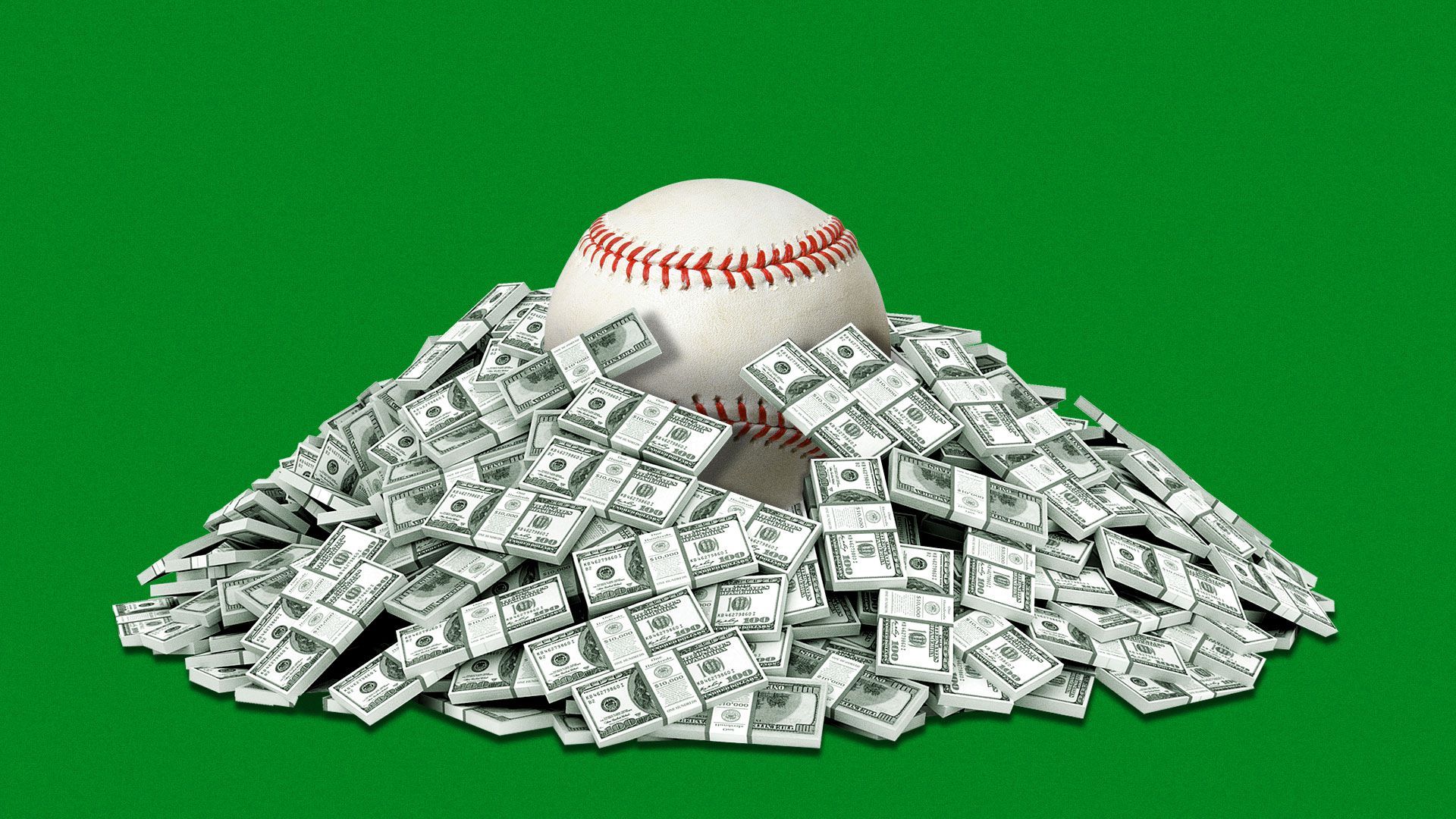 | | | Illustration: Eniola Odetunde/Axios | | | | For the first time in 27 years, MLB has canceled regular-season games because of a labor fight, as the longest lockout in its history rolls on. State of play: For months, MLB and its players' union have accused each other of not wanting to strike a deal — a "deeply cynical premise" that illustrates the disconnect between them, as ESPN's Jeff Passan puts it. - Every day there isn't a game, players lose $20.5 million in salary, and teams move closer to having to provide rebates to regional sports networks (starts around ~25 games missed).
- Public support is seemingly with the players, but time is on the owners' side. Because of the rebate threshold and low April attendance, they may be perfectly fine missing the first month.
- The optics couldn't be worse, as this labor dispute — hardly a matter of life and death — plays out against the backdrop of war.
What they're saying: MLB commissioner Rob Manfred announced Tuesday that the first two series have been canceled and will not be made up. So the earliest the season could begin is April 7. - "A lockout is the ultimate economic weapon," said MLBPA executive director Tony Clark. "But [we] won't be intimidated."
- "The unfortunate thing is the agreement we offered players had huge benefits to fans and players," said Manfred.
Between the lines: The owners are largely viewed as having "won" the past two CBA agreements, so the union is playing catch up in a sense, needing bigger wins than they would have needed if these negotiations were happening in a vacuum. - "In truth, this day was five years in the making, ever since the players whiffed on the last CBA," writes SI's Tom Verducci.
- The deep distrust the players have for the owners — thanks to things like secretly-juiced baseballs and Manfred calling the World Series trophy "a piece of metal" — hasn't helped.
The big picture: The irony of these negotiations — as important as they are to MLB's future — is that they mostly address economic concerns rather than baseball's biggest problem: the on-field product. - Games are too slow and stagnant, causing fans to lose interest. Data-driven front offices run teams like Fortune 500 companies, often prioritizing efficiency over entertainment.
- This sense of unease about how baseball is played has bled into negotiations about how money is distributed, with the union and ownership bringing a certain level of anger to the table.
What's next: After eight consecutive days of bargaining, both sides will take some time to regroup. It's unclear when they'll meet again, but sources indicate it will likely be within the next week. Go deeper: How MLB can salvage the season (ESPN) |     | | | | | | 2. Core issue: Competitive Balance Tax |  Data: theScore; Chart: Thomas Oide/Axios The Competitive Balance Tax (CBT) as we know it came about in 2003. The problem? It hasn't helped achieve competitive balance. How it works: The CBA dictates a dollar amount that teams can pay in annual player salaries. Teams who exceed that threshold are taxed on the overage, and the tax rates get worse the further they exceed it. - The Dodgers and Padres were the only teams to exceed last season's threshold, which was $210 million. They paid penalties of $32.7 million and $1.3 million, respectively.
- Just nine teams have ever exceeded the threshold, and just three have done so more than twice: Yankees (15), Red Sox (10) and Dodgers (5).
State of play: Players want to increase that threshold to encourage spending. The owners are willing to raise it, but not as much as the players would like. The result is a fairly large gap in their five-year proposals. - 2022: $238M (MLBPA) vs. $220M (MLB)
- 2023: $244M vs. $220M
- 2024: $250M vs. $220M
- 2025: $256M vs. $224M
- 2026: $263M vs. $230M
The big picture: The goal of the CBT was to achieve competitive balance by disincentivizing big market behemoths from vastly outspending their smaller-market peers. But players think it has failed, and has instead become a de facto salary cap that impedes spending. - They have a point: In the 19 seasons since CBT was implemented, fewer teams have played in (19) and won the World Series (13) than in the 19 seasons prior (20 and 14). And since 2012, the CBT threshold has increased just 18% while MLB revenues have increased 40%.
- Owners disagree with the notion that the CBT has become a salary cap, and they believe increasing the amount of money teams can spend pre-tax will give the richest teams a greater advantage.
|     | | | | | | 3. Core issue: Minimum salaries |  Data: TheScore; Table: Thomas Oide/Axios "Millionaires vs. billionaires" is a catchy line, but it overestimates how much money most MLB players make. By the numbers: MLB's minimum salary ($570,500) is by far the lowest among the Big Four (NFL, $660,000; NHL, $750,000; NBA, $925,258). And unlike those other leagues, a majority of MLB players make the minimum. - 63.2% of players in 2019 had less than three years of service time, per TheScore, and were thus making the minimum or close to it.
- By comparison, just 3% of NBA players last year made within 10% of the minimum.
State of play: The union wants to increase the minimum salary, and the two sides are actually not that far off. - The union wants it raised to $725,000 this year, $765,000 by 2024 and further increases in 2025-26 based on the consumer price index for urban wage earners.
- The owners' final offer began at $700,000 this year, followed by annual increases of $10,000. So we're talking about a difference of a few thousand dollars.
The bottom line: If the MLBPA caved and accepted MLB's offer, it's already a pretty big win ($570,500 to $700,000). But the union is going to push for every dollar, as it should, given that minimum salaries impact the majority of its members. |     | | | | | | A message from Axios | | Advertise in Axios Sports | | |  | | | | Are you a marketer looking to reach decision makers who care about sports? Consider advertising with us: - Reach hundreds of thousands of people daily.
- Achieve your KPIs around business development, awareness, and product sales.
- Over 60% of our audience earns six figures per year and makes business purchasing decisions.
Let's Chat | | | | | | 4. Core issue: Paying young players sooner |  Data: Stathead; Chart: Thomas Oide/Axios MLB's economic system is set up in such a way that the most productive players make the least amount of money. Fixing that system is at the heart of these negotiations. The backdrop: Between time spent in the minors and the six years of service time required before hitting free agency, most players are past their prime by the time they can freely negotiate their salary. - In the past, there was a pot of gold at the end of the rainbow as teams often overpaid veterans for past performance (see: Albert Pujols and Miguel Cabrera).
- But that's gone away in recent years, with analytics-savvy teams realizing they can stock their roster with cheaper, younger players.
By the numbers: Players in their age-29 season or younger last season generated 63% of all wins above replacement, but earned just 38% of MLB's total salaries, per FiveThirtyEight. Between the lines: The gap between pay and performance for younger players has been a central focus for the MLBPA, and the league has shown a willingness to address some of the union's concerns. - Service time manipulation: The best young players are often held back in the minors to keep them from accruing a full year of service time. MLB has agreed to an incentive system to encourage clubs to promote those players, which is promising.
- Pre-arbitration bonus pool: The union proposed an $85 million bonus pool (with $5 million annual increases) to reward the best players who have fewer than three years of service time. The league has upped its offer to $30 million, but it still pales in comparison.
|     | | | | | | 5. Core issue: Expanded postseason |  Data: MLB; Table: Connor Rothschild and Will Chase/Axios Another hot topic in negotiations — and the simplest one for fans to understand — is an expanded postseason. Where it stands: The current 10-team format has been in place since 2012 (aside from 2020's shortened season, when it was 16). - The owners want to expand to 14 teams, which would reportedly net them an additional $100 million annually from ESPN.
- The players prefer 12, fearing that a 14-team field would decrease spending since teams could sneak in with mediocre records.
For your consideration ... Using last season as an example (see above), a 12-team field would have seen the addition of the Blue Jays and Reds, while a 14-team field would have also included the Mariners and Phillies. |     | | | | | | 6. The business of baseball |  Data: Sportico; Table: Thomas Oide/Axios COVID aside, it's a pretty great time to be an MLB owner. The big picture: Valuations are booming, with the average franchise worth $2.2 billion, per Sportico's 2021 analysis. Teams are collectively worth nearly four times what they were just 10 years ago, per Forbes. - The 2019 season was the 17th straight year that MLB set a new revenue record ($10.8 billion).
- The pandemic wreaked havoc in 2020 and 2021, as it did for all sports leagues, but a look at the reigning champions' finances suggests that teams were able to rebound.
Between the lines: The Braves, the only franchise legally required to open its books due to public ownership, posted a record $568 million in revenue in 2021. - That's up 19% from the $476 million in revenue the team posted in 2019, evidence of a COVID recovery.
- Of note: The Braves won the World Series, benefitting from a lengthy playoff run and fewer attendance restrictions than most. So they're not the best depiction of the average MLB team, but it's the best we have.
What they're saying: Naturally, the union and league have interpreted these figures differently, with players focusing on the huge revenue number and owners highlighting the fact that the Braves only netted $20 million in operating income. |     | | | | | | 7. A brief history of work stoppages | 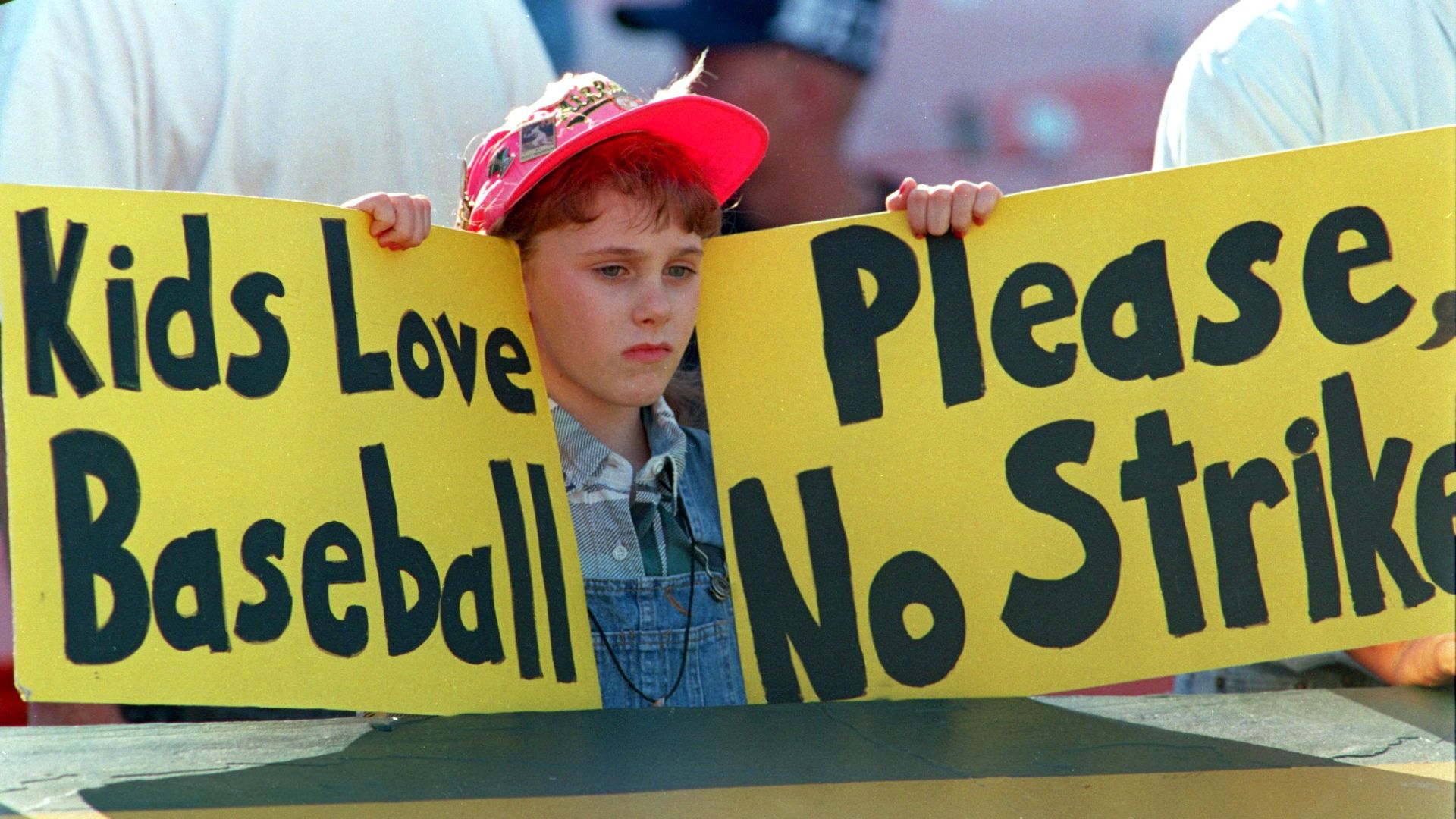 | | | A young baseball fan shows her disapproval of the strike in 1994. Photo: Jed Jacobsohn/Getty Images | | | | This is MLB's ninth work stoppage, comprising five strikes and four lockouts. While the strikes resulted in 1,737 canceled games, the lockouts resulted in zero — until now. - 1972 strike (86 games lost): 16 years after the MLBPA was formed, and six years after it elected Marvin Miller as executive director, players went on strike to achieve an increased pension fund.
- 1973 lockout (0): After a 17-day lockout that delayed spring training, the sides agreed on a three-year CBA that began the practice of arbitration.
- 1976 lockout (0): An independent arbitrator struck down the reserve clause, giving players the right to become free agents. Owners feared that future, but their lockout was short-lived after a federal judge upheld the arbitrator's ruling.
- 1980 strike (0): Contentious CBA negotiations led to the week-long strike, which ended when the sides agreed to continue talks during the season. They reached a deal on everything except free-agent compensation, which blew up the following year.
- 1981 strike (713): Owners wanted compensation in return for losing free agents, and players went on strike from June to August, resulting in a one-of-a-kind split season.
- 1985 strike (0): This two-day strike had significant ramifications — owners were so angry they colluded to suppress the free-agent market and ultimately had to pay the players $280 million in damages.
- 1990 lockout (0): Then-commissioner Fay Vincent's handling of the lockout led to his ouster, and he was replaced by former Brewers owner Bud Selig.
- 1994-95 strike (938 games): The owners' insistence on a salary cap led to a strike that ate into two seasons and canceled the 1994 World Series. 27 years of (relative) harmony followed. Now, we're here.
|     | | | | | | 8. The social media lockout | 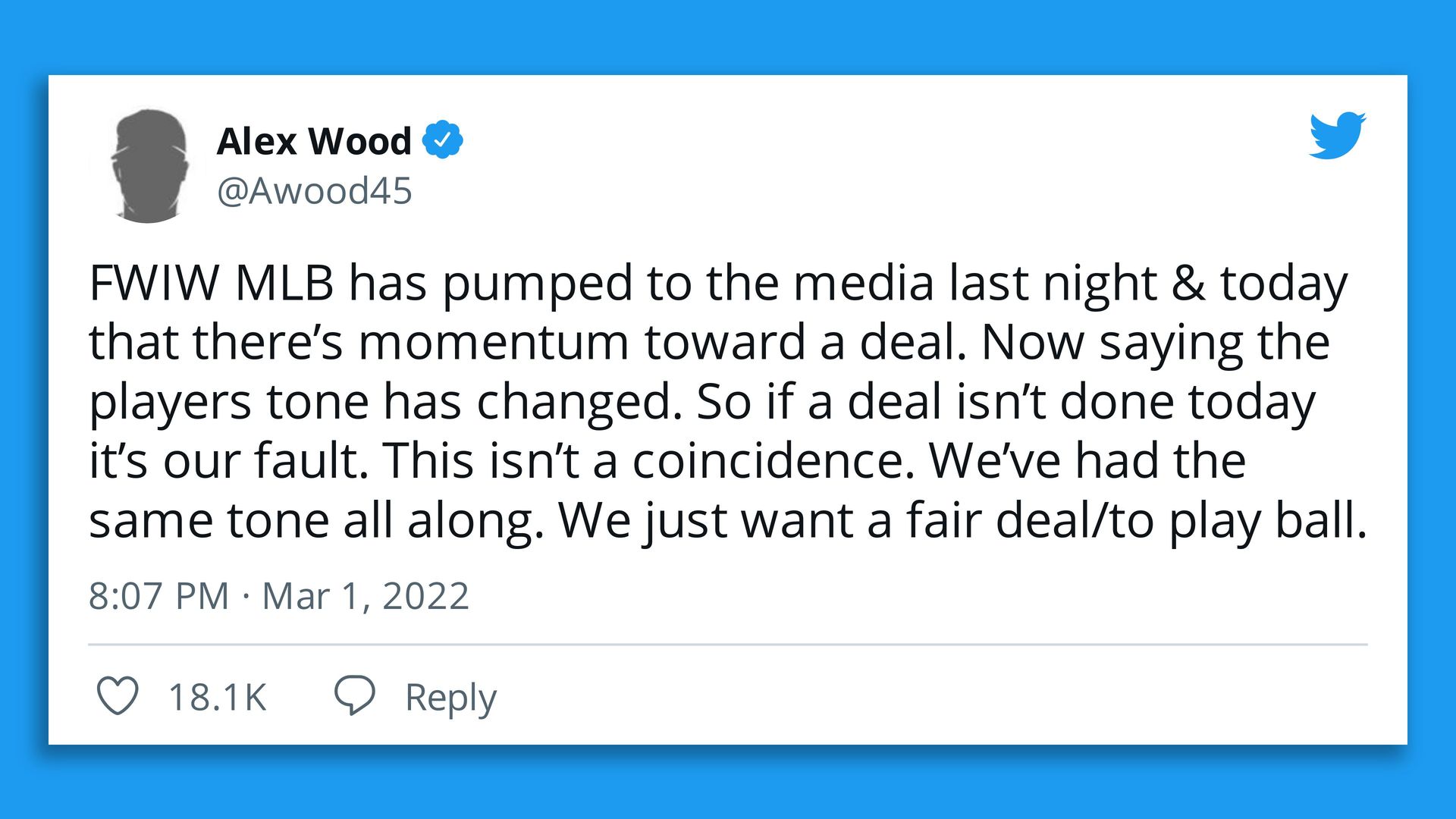 | | | Screenshot: Giants pitcher @Awood45 (Twitter) | | | | This is the first MLB work stoppage of the social media age, which has changed the perception of the negotiations. Why it matters: The message isn't coming solely from written statements and quotes from spokespeople — it's coming directly from players. - "Unlike every other critical point in baseball's history, these negotiations are playing out in the public sphere," writes The Athletic's Brittany Ghiroli (subscription).
- "Today's players are smarter and savvier than previous generations in combating the 'greedy millionaire' rhetoric often lobbed their way by fans."
What they're saying: Numerous players have posted their thoughts on Twitter and Instagram in recent days. Three-time MVP Mike Trout weighed in on Wednesday: "I want to play, I love our game, but I know we need to get this CBA right. Instead of bargaining in good faith, MLB locked us out. Instead of negotiating a fair deal, Rob canceled games. Players stand together. For our game, for our fans, and for every player who comes after us." |     | | | | | | 9. ⚾️ MLB trivia | 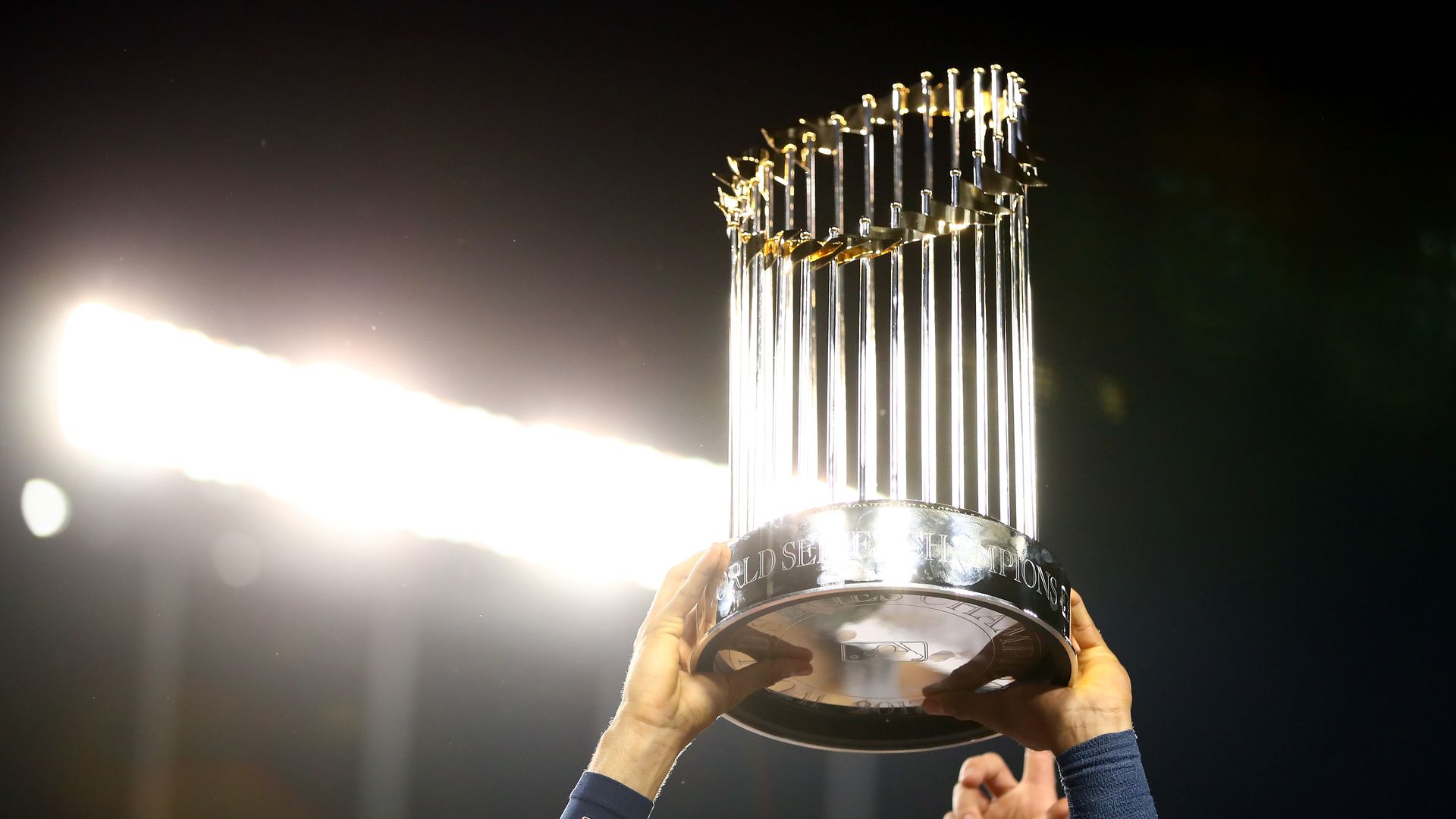 | | | Photo: Ezra Shaw/Getty Images | | | | Six franchises have won multiple World Series since the 1994-95 strike. - Question: Name them.
- Hint: Two in one league, four in the other.
Answer at the bottom. |     | | | | | | 10. 1 fun thing: Harper to Japan? | 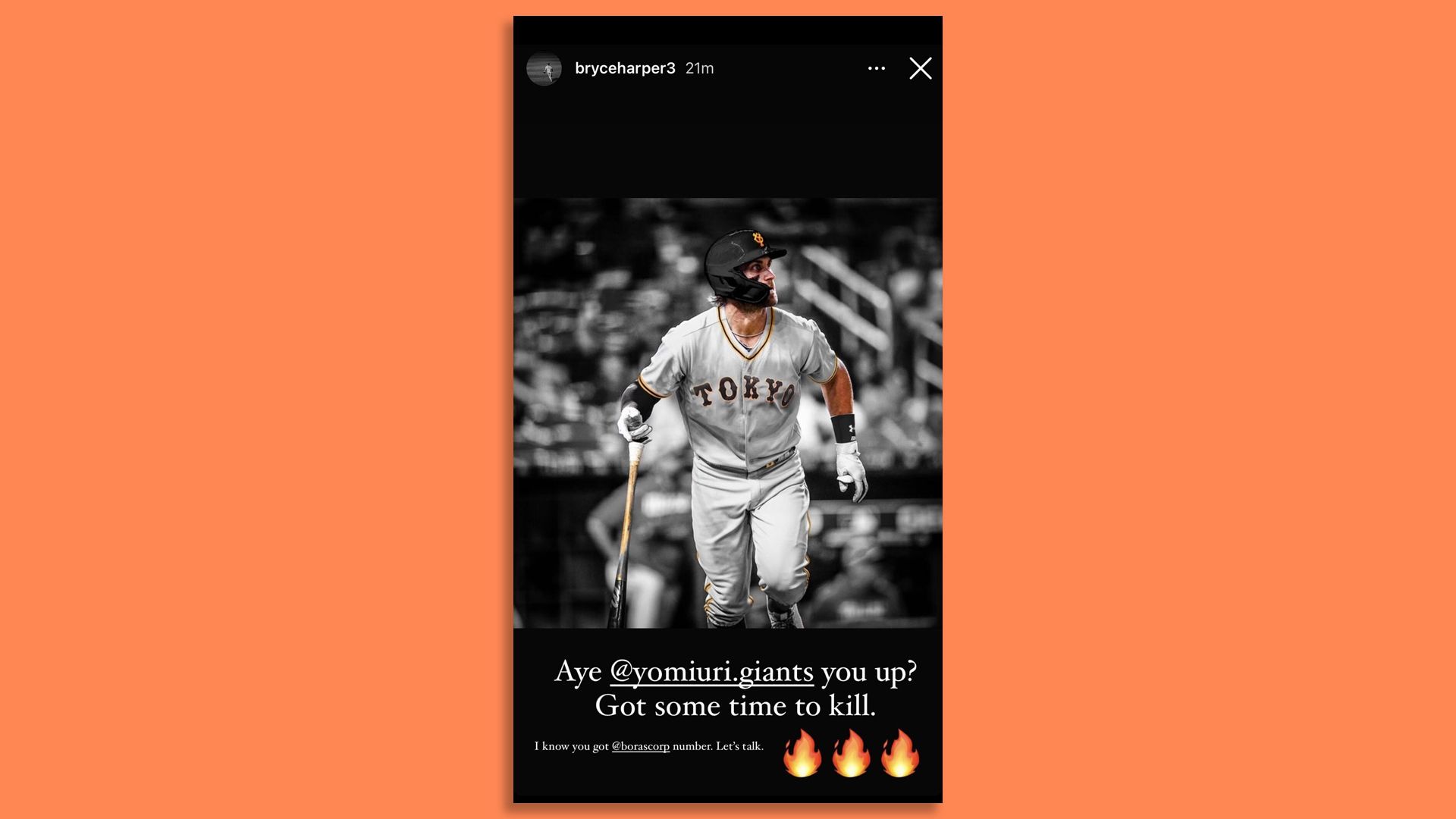 | | | Screenshot: @bryceharper3 (Instagram) | | | | Earlier this week, reigning NL MVP Bryce Harper shared a photo of himself on Instagram in a Yomiuri Giants (Japan) uniform, suggesting they reach out to his agent. The intrigue: The chances of Harper playing in Japan are slim to none, but it begs the question: Would this be allowed? The short answer is yes, according to the work stoppage guide distributed to the players: "The PA would challenge any attempts by MLB to interfere with Players who choose to participate in a foreign league during a lockout. During the 2004-05 work stoppage, a large number of NHL Players chose to play internationally." On a related note ... Remember when the Phillies tricked Kyle Kendrick into thinking he'd been traded to the Yomiuri Giants? It's a classic prank, and a much-needed baseball laugh. Enjoy. |     | | | | | | A message from Axios | | Advertise in Axios Sports | | |  | | | | Are you a marketer looking to reach decision makers who care about sports? Consider advertising with us: - Reach hundreds of thousands of people daily.
- Achieve your KPIs around business development, awareness, and product sales.
- Over 60% of our audience earns six figures per year and makes business purchasing decisions.
Let's Chat | | | | Talk tomorrow, Kendall "My brain hurts but it was worth it" Baker Trivia answer: Yankees (5), Red Sox (4), Giants (3), Cardinals (2), Marlins (2), Braves (2) 🙏 Thanks for reading. Be sure to follow us at @kendallbaker and @jeffreytracy, and tell friends to sign up here. |  | Bring the strength of Smart Brevity® to your team — more effective communications, powered by Axios HQ. | | | | | | Axios thanks our partners for supporting our newsletters. If you're interested in advertising, learn more here.
Sponsorship has no influence on editorial content. Axios, 3100 Clarendon Blvd, Suite 1300, Arlington VA 22201 | | | You received this email because you signed up for newsletters from Axios.
Change your preferences or unsubscribe here. | | | Was this email forwarded to you?
Sign up now to get Axios in your inbox. | | | | Follow Axios on social media:    | | | | | |














No comments:
Post a Comment